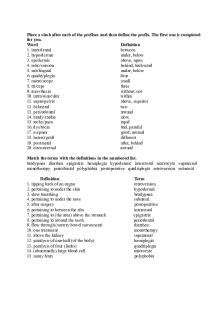3 term Contingency/Stimulus Control/Generlization PDF

| Title | 3 term Contingency/Stimulus Control/Generlization |
|---|---|
| Course | Introduction to ABA: History and Principles |
| Institution | Seneca College |
| Pages | 2 |
| File Size | 112.6 KB |
| File Type | |
| Total Downloads | 57 |
| Total Views | 139 |
Summary
Breakdown of the 3 term contingency (ABC), Stimulus Control and Generlization for lectures 1 & 2 of BHS202 with Prof. Kelly Alves. ...
Description
Examples for Self-Assessment (Stimulus Control) 1. A man says “I love you” to his wife but not to any of the people where he works. Antecedent → Behavior → Consequence His wife is present → He says “I love you.” → She says the same to him. 2. When the stop light is red, you stop. When it is green, you go. Antecedent → Behavior → Consequence Green light. → You press the accelerator. → You travel to where you are going and avoid people honking at you. 3. You tell off-color jokes to your friends but not to your parents or teachers. Antecedent → Behavior → Consequence Your friends are present. → You tell off-color jokes. → They laugh and tell you jokes. 4. When the phone rings, you pick it up and talk to the person who called. Antecedent → Behavior → Consequence The phone rings → You answer the phone → You talk to the person who called. 5. When the light on the rechargeable electric drill is on, you use the drill. Antecedent → Behavior → Consequence The light on the rechargeable drill is on. → You take the drill and use it to drill a hole. → The drill works fine.
The Three-Term Contingency According to Skinner (1969), stimulus discrimination training involves a three-term contingency, in which the consequence (reinforcer or punisher) is contingent on the occurrence of the behavior only in the presence of the specific antecedent stimulus called the SD. As you can see, a three-term contingency involves a relationship among an antecedent stimulus, a behavior, and the consequence of the behavior. Behavior analysts often call this three-term contingency the ABCs (antecedents, behavior, consequences) of a behavior (Arndorfer & Miltenberger, 1993; Bijou, Peterson, & Ault, 1968). The notation used to describe a three-term contingency involving reinforcement is as follows: SD → R → SR where SD = discriminative stimulus, R = response (an instance of the behavior), and SR = reinforcer (or reinforcing stimulus). The notation for a three-term contingency involving punishment is as follows: SD → R → SP In this case, SP = punisher (or punishing stimulus). As you can see, an antecedent stimulus develops stimulus control over a behavior because the behavior is reinforced or punished only in the presence of that particular antecedent stimulus. The same holds true for extinction. When a behavior is no longer reinforced in a particular situation (in the presence of a particular antecedent stimulus), the behavior decreases in the future only in that particular situation.
Generalization In some cases, the antecedent conditions in which a behavior is strengthened (through reinforcement) or weakened (through extinction or punishment) are fairly specific; in others, the antecedent conditions are more broad or varied. When the stimulus control of a behavior is more broad—that is, when the behavior occurs in a range of antecedent situations—we say that stimulus generalization has occurred. Generalization takes place when a behavior occurs in the presence of stimuli that are similar in some ways to the SD that was present during stimulus discrimination training (Stokes & Osnes, 1989). According to Skinner (1953a, p. 134), “Generalization is … a term which describes the fact that the control acquired by a stimulus is shared by other stimuli with common properties.” The more similar another stimulus is to the SD, the more likely it is that the behavior will occur in the presence of that stimulus. As stimuli are less and less similar to the SD, the behavior is less and less likely to occur in the presence of these stimuli. This is called a generalization gradient (Skinner, 1957). Figure 7-1 presents an example of a generalization gradient from a study by Guttman and Kalish (1956). Guttman and Kalish reinforced key-pecking in pigeons when the key was illuminated with a certain wavelength of light. As a result, the light was an SD that developed...
Similar Free PDFs

Sociology 293 Term 3
- 12 Pages

Exam 2019 term 3
- 10 Pages

Term 3 English Notes
- 18 Pages

Term 1 Lab 3 ELN
- 6 Pages

Week 3 Medical Term Assignment
- 2 Pages

Group 3 Mid-term Report
- 19 Pages

Exam 2014, questions - term 3
- 8 Pages

ECON2004 Term 2 Problem Set 3
- 9 Pages

3 Idiots END TERM Report MOB
- 13 Pages

Term 3 2021 COMM1000 course outline
- 15 Pages
Popular Institutions
- Tinajero National High School - Annex
- Politeknik Caltex Riau
- Yokohama City University
- SGT University
- University of Al-Qadisiyah
- Divine Word College of Vigan
- Techniek College Rotterdam
- Universidade de Santiago
- Universiti Teknologi MARA Cawangan Johor Kampus Pasir Gudang
- Poltekkes Kemenkes Yogyakarta
- Baguio City National High School
- Colegio san marcos
- preparatoria uno
- Centro de Bachillerato Tecnológico Industrial y de Servicios No. 107
- Dalian Maritime University
- Quang Trung Secondary School
- Colegio Tecnológico en Informática
- Corporación Regional de Educación Superior
- Grupo CEDVA
- Dar Al Uloom University
- Centro de Estudios Preuniversitarios de la Universidad Nacional de Ingeniería
- 上智大学
- Aakash International School, Nuna Majara
- San Felipe Neri Catholic School
- Kang Chiao International School - New Taipei City
- Misamis Occidental National High School
- Institución Educativa Escuela Normal Juan Ladrilleros
- Kolehiyo ng Pantukan
- Batanes State College
- Instituto Continental
- Sekolah Menengah Kejuruan Kesehatan Kaltara (Tarakan)
- Colegio de La Inmaculada Concepcion - Cebu





